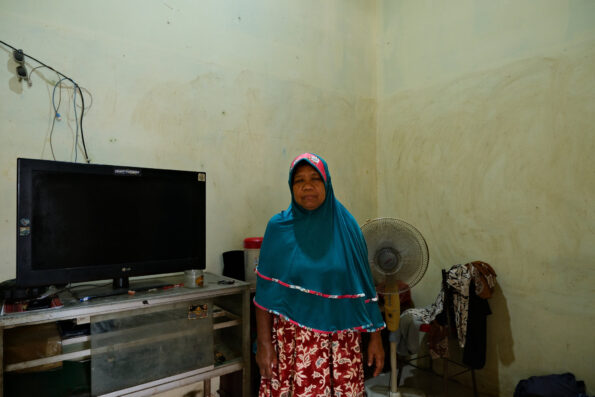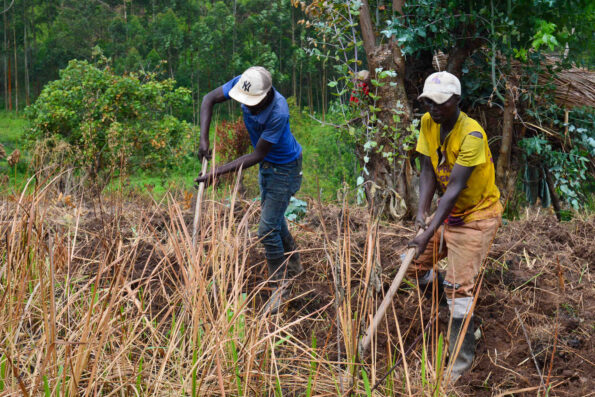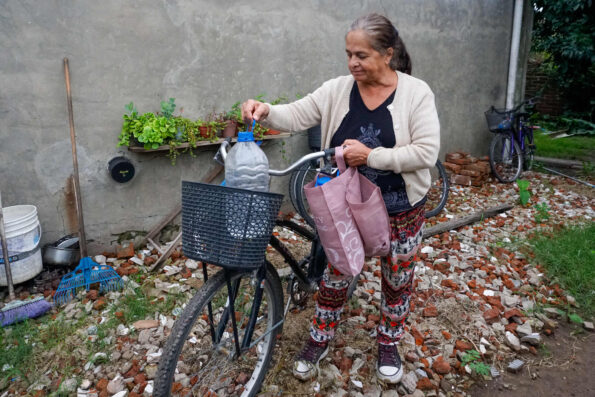
SELIBE-PHIKWE, BOTSWANA – Segwabe Morathi, a retired religious minister, works as a farmer in a village on the outskirts of Selibe-Phikwe, a small mining town in eastern Botswana. He says farming is not easy in Botswana, where a semiarid desert means that the weather is unpredictable. A changing climate has only made rain more unreliable, he says.
Morathi says he has spent precious time ploughing his field with the expectation of more rains, but to his disappointment, the intense heat has consumed all the young seedlings.
Across the country, rain has become less frequent, while intense heat – tempatures can reach higher than 104 degrees Fahrenheit – continues to cause a multitude of problems for both people and industries.
Experts here say that malnutrition and undernourishment that result from unpredictable crop yields leave people with perilous health conditions, such as HIV/AIDS and tuberculosis, even more vulnerable. One in four adults in Botswana is HIV-positive, giving it the world’s second-highest HIV-prevalence rate.
While rain in the south varies, Morathi says that the northern part of the country has received a lot of rain. He says that the area – home to the Okavango Delta, where a river empties into a swamp spanning 11,000 kilometers – is a breeding ground for mosquitoes, leading to more cases of malaria. Throughout Botswana, women and children are the ones who are most prone to malaria because they are the ones who search for food, fish in the rivers and transport tourists in their canoes.
Morathi says that Botswana has four regions – north, south, east and west – and that each has different weather, which makes it hard for the government to create a plan.
But the Botswana government has warned citizens of malaria, taught them about it, and provided remedies with regards to climate changes and malaria infections, he says. Morathi says the government has also approved the construction of a new dam, which would help ease the intense heat since moisture evaporating from it will help cool the area.
Climate change experts here say temperatures are increasing and rain is decreasing in Botswana, which hurts crop yields, increases food insecurity and creates health problems for Botswanans. Health officials say malnutrition and undernutrition caused by climate change leave people more vulnerable to weakened immune systems and, therefore, the symptoms of HIV/AIDS and TB, and a higher concentration of carbon dioxide enables primary malaria agents to spread. The government has implemented programs to tackle HIV/AIDS, TB and malaria and has begun to study climate change to understand how Botswana is vulnerable and must adapt.
Botswana is on track to combat HIV/AIDS, malaria and other diseases – goal six of the Millennium Development Goals, MDGs, a U.N. initiative agreed to by countries worldwide to achieve by 2015, according to the MDG Monitor. And advocates say it is possible for Botswana to meet goal seven – to ensure environmental sustainability – if some changes are made.
Meteorologist Dorcus Masisi, principal officer of the Botswana Department of Meteorological Services, says that temperatures have been increasing and rainfall has been decreasing in Botswana in recent years. Records show that the number of days reaching the minimum temperature has been decreasing, while the number of days reaching the maximum temperature has been increasing. Meanwhile, she says rainfall has decreased and become unreliable.
She says the changes in these key climate elements have been negatively affecting agriculture. Studies of two regions in Botswana with contrasting soil conditions both showed declines in the yields of maize and sorghum – Botswana’s primary crops, which occupy about 75 percent of farmland. She says the changing climate has also affected the grasslands and, in turn, livestock, which many here rely on for food and income.
She predicted that changing conditions would only continue to negatively affect the agriculture and livestock sectors.
“The country is highly susceptible to seasonal variations in climate that contribute to drought conditions, which, in turn, reduce water supply, and both agricultural productivity and output,” according to a joint government and U.N. 2010 MDG status report. “Droughts affect the livelihoods of the many that are dependent on agriculture and rural communities that depend on individual water sources that cannot withstand prolonged drought.”
Because the country lacks an adequate monitoring system and long-term data sets are scarce, predicting the severity and extent of droughts is difficult, according to the report.
Kgomotso Mmoko, who works in the Ministry of Health’s Department of Environmental Health, says that climate change is the latest threat to the world’s growing HIV/AIDS epidemic. He says that climate change will lead to food scarcity and poor nutrition, which weaken the immune system against viruses and diseases, such as HIV/AIDS and TB. He says proper nutrition is essential to the body’s ability to fight diseases. Other factors associated with climate change – poverty, unemployment, mobile populations – also leave people more vulnerable, he says.
He says that changing climate conditions, such as increased concentrations of carbon dioxide in the atmosphere, also mean changing pest trends. He says this will allow the primary malaria agent to spread to new areas.
Puni Molaodi, of Silence Kills, a nongovernmental organization in Selibe-Phikwe, tests women for HIV/AIDS and cares for HIV patients and vulnerable children. She says that only two people of the 65 who have been tested between December 2010 and February 2011 were HIV-positive, but that this doesn’t reflect the reality in the region because the same people always return for testing.
She says that the intense summer heat tortures people living with HIV/AIDS, who prefer the cool weather in the winter because they struggle to sleep in the heat.
Because of the intense heat, people who are sick say they prefer staying in thatched-roof houses, which tend to be cooler. But these houses are mostly located in rural areas, while the care these patients need is located in towns. Paying for bus fares and carrying their belongings in the heat to commute back and forth makes staying in rural areas difficult. So patients say they opt to sleep outside rather than in houses with roofs made from corrugated iron sheets.
Molaodi says that people with HIV/AIDS are also more prone to TB. She says that taking drugs for both daily weakens them, which is exacerbated by food insecurity created by climate change.
Utlwanang Keitumetse, who lives in Mogapi, a village outside Selibe-Phikwe, has been living with AIDS for the past eight years. She says that increasing outbreaks of TB lately have posed a serious threat to people who are HIV-positive. Because of the scarcity of accommodation, women and children are forced to sleep in one room with the patients, leading to a higher rater of TB transmission.
Kefilwe Mokgaotsane, a journalist for Botswana Television, says that because of climate changes today, it is difficult for the government to assist in the fight against malaria because the unpredictability of the rain makes it hard to distribute mosquito nets to damp areas. She says that the rains are also so destructive when they come that they leave many women homeless and, therefore, vulnerable to health risks.
According to the joint government and U.N. 2010 MDG status report, Botswana has made progress against malaria and HIV/AIDS, but there have been setbacks when it comes to TB because of HIV/AIDS.
Mmoko says that the government has implemented strategies, policies and programs to combat HIV/AIDS, TB and malaria. He says it supports research, mobilizes local and foreign resources, monitors and evaluates results and coordinates with the global community on strategies.
Attributing climate change to the imbalance of gases in the atmosphere, Mmoko says that industry gas emissions must be monitored.
Botswana contributes 7 percent of Africa’s greenhouse gas emissions, according to the MDG status report. Carbon dioxide emissions have increased slightly and forest area has decreased slightly.
Botswana has ratified several multilateral environmental agreements on climate change and has been implementing a new Environmental Information System to improve data, according to the report. The government is conducting studies to better understand the interaction between climate, society and environment in order to see how the country is vulnerable and how it must adapt. Because climate change projections predict a shorter and less reliable rainfall season, the government’s focus is on careful management of natural resources, biodiversity and ecosystems, in addition to energy efficiency and conservation.







